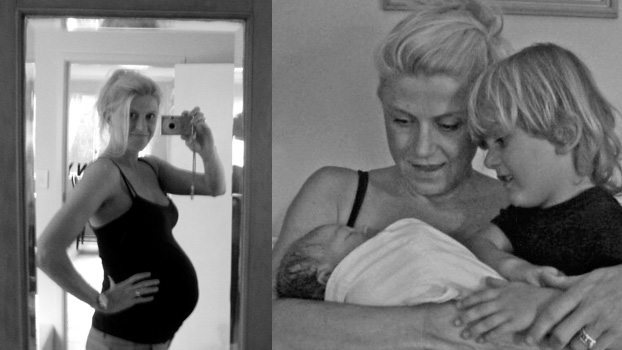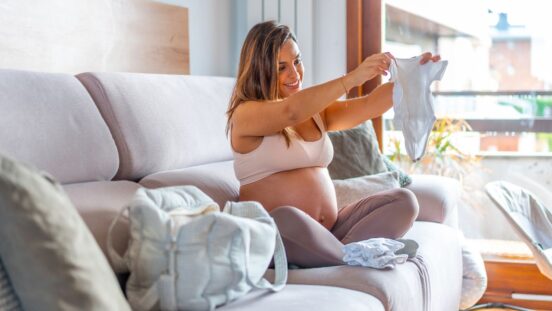How I learnt to fight my fear of childbirth

A good birthing horror story can be fascinating, but not when you’re a first-time mum already scared out of her overstretched skin
When facing her fears around childbirth, Amelia Bloomfield found that writing down a labour-day game plan helped boost her confidence. Now a mother of two, she shares her personal how-to for penning a birth plan.
During my first pregnancy, I was a little baffled by how many women (including close friends and family) would delight in telling me their birthing horror stories. The gory details would be dramatised in full colour until I'd squirm and cross my legs with fear.
In due time, I discovered that giving birth is indeed a mind-boggling experience and for some it's truly traumatic, but I still don't get the whole culture of prepping expectant mums to 'be ready to go to hell and back!'
I realise that for many women, venting about the horrors of labour can be a healing process, like sharing war stories.
But I reckon first-time mums need to hear more about the victories, heroes and homecomings of war, and not just the gore of the battle fields.
As my own B-day approached, I knew I wanted to try to 'go natural' but I was gripped with fear about the unknowns. I wondered what my pain threshold was like, among other things.
I knew it was foolish to think I could have any real control over the experience, but I felt like I needed some sort of strategy to help reduce any confusion or conflict in the event that things didn't progress as we hoped. On the advice of my amazing midwife, I sat down and wrote birth plan.
OK, so no cleverly worded labour-ward wishlist is going to take the pain away (and so-called 'birth plans' are notorious for not going to plan!), but as I discovered, it may just lower your anxiety levels before those contractions begin.
Whether you have a relatively speedy, hassle-free birth or a marathon labour that finishes with you being flipped onto an operating table, a birth plan will at least communicate your wishes to all involved.
My birth plan below may not be exactly what you're into, but it can be used as a starting point to help you and your partner consider where you stand on issues like pain relief and intervention, who will be present, and your preferred birthing environment.
AMELIA'S BIRTH PLAN
Location: Mullumbimby Hospital Birth Centre
Estimated due date: February 7
Midwife: Leanne Crumpton (or alternative member of midwife team if Leanne unavailable)
Assisted by: Heidi Smith (trainee midwife)
Birth companions: Hunter McKenzie (husband) or Sharon McGrath (best friend)
BASIC BIRTH IDEALS
Depending on the health and wellbeing of Amelia and the baby, our preference is to labour in the Mullumbimby Hospital Birth Centre using the birthing bath/pool and other active birthing aids and ending with a water birth.
If length of labour, complications or unbearable levels of pain require a move to another facility, this will be discussed with Amelia and Hunter and further pain relief such as an epidural will be made possible after due consideration.
Unless medically vital, a caesarean delivery is an undesirable option.
ATMOSPHERE
Preferably a calm, dimly lit, quiet environment – Amelia, however, is allowed to yell as much as she likes – with our own music, if desired.
Hospital team and support people to be minimal and Sharon will be present only if Hunter is away working offshore when labour commences.
MONITORING
We would like all monitoring (mother and baby) to be kept to a minimum and prefer that Leanne use a hand-held device to intermittently check on baby's heartbeat, rather than Amelia being hooked up with a belt-style monitor.
PAIN MANAGEMENT
Hunter will be there throughout the birth and possibly in the birthing bath when the time comes.
Amelia will be using a TENS machine to help with pain relief from when her contractions first begin. This will only be removed when she enters the bath or shower. She would like to use the birthing bath for both pain relief (if required) and to give birth in.
Hunter will be assisted by our midwife Leanne to remind Amelia of pain management techniques, positions, breathing and to give encouragement, particularly during the 'transition' stage of labour.
We trust Leanne to remind Amelia of useful positions, to assist with breathing and to give advice on when to pant/push if required. See above for epidural protocol.
INTERVENTION & CAESAREAN
If Amelia or the baby's health requires intervention (Oxytocin, forceps, suction, etc), Amelia and Hunter are to be kept fully informed of the circumstances requiring this and options available.
A caesarean is only to be performed in the case of an emergency.
IMMEDIATELY AFTER DELIVERY
Hunter is to cut the umbilical cord. We would prefer the baby not be washed, wiped down or swaddled until skin-to-skin contact has been established and an attempt at suckling made.
Skin-to-skin contact is to be given immediately after the birth (including if a caesarean delivery has taken place), unless emergency circumstances preclude this.
If general anaesthetic has been required and Amelia is unable to make immediate contact with the baby, Hunter is to maintain as much skin-to-skincontact as his hairy chest will allow.
Amelia is happy for the third stage of labour (delivery of placenta and membranes) to be assisted by drugs/injection.
We don't require that the placenta be saved for us to take home.
We would like the baby to be given Vitamin K and Hepititis B injections.
Our ultimate wish, however the birth pans out, is for a safe and positive experience for all!




